The NCRB’s ‘Crime in India’ report provides data on volume & amount of the fake currency seized in the country. The 2018 data indicates that the number of fake ₹ 2000 notes seized has decreased while it has increased in the case of ₹ 500 notes.
Addressing the nation on the eve of announcing demonetization, Prime Minister Narendra Modi stated that terrorism across the border is being funded by Fake currency notes and that there have been many instances where fake currency of the then high value notes of ₹ 500 and ₹ 1000 were seized. Curbing fake currency was one of the stated goals of demonization.

Factly had done a story earlier on the impact of demonetization, as part of which details of fake currency post demonetization based on RBI’s Annual Report was also discussed.
Apart from the newly introduced high value currency of ₹ 500 and ₹ 2000, large number of counterfeit notes of lower denomination like ₹100 were also identified. The numbers reported by RBI are those notes which have been identified in the Banking system. The RBI annual report also reports numbers for the financial year (from April to March).
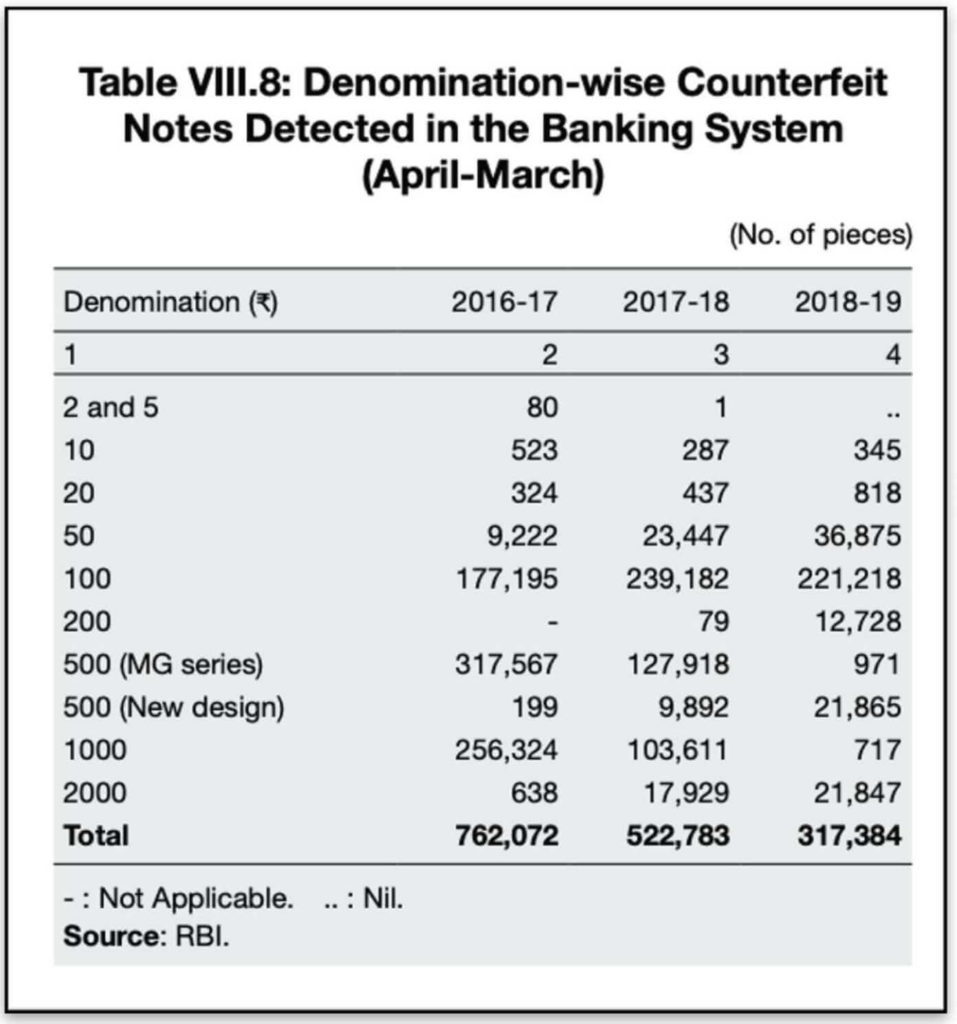
On the other hand, the NCRB (National Crime Reports Bureau) annual ‘Crime in India’ report provides details of the cases registered in the seizure of Fake Indian Currency Notes(FICN). Unlike FICN in the banking system as reported by RBI, the NCRB data provides details of the fake currency seized across the country by law enforcement agencies. The NCRB’s 2018 report was recently released.
It is to be noted that counterfeiting currency is a punishable offence under Indian law. Sections 489 A to 489 E of Indian Penal Code lay down these provisions.
Highest number of cases in 2018 registered in Uttar Pradesh, followed by West Bengal
As per the data provided in NCRB-2018 report, a total of 914 FIRs were registered across all India in 2018 related to seizure of Fake Indian Currency Notes. There were a total of 1002 accused in these cases.
Highest number of cases were registered in Uttar Pradesh (206 FIRs in which 68 were accused). While West Bengal has the second highest number of FIRs with 158, it has the highest number of accused in these cases with 187. Among the other states, Tamil Nadu and Gujarat have higher number of FIRs with 72 and 67 respectively.
The number of FIRs registered have come down over the past three years. In 2016, there were 1172 FIRs while in 2017 the number was 978. The number of accused was also higher in 2017 and 2018 with 1107 and 1046 respectively.
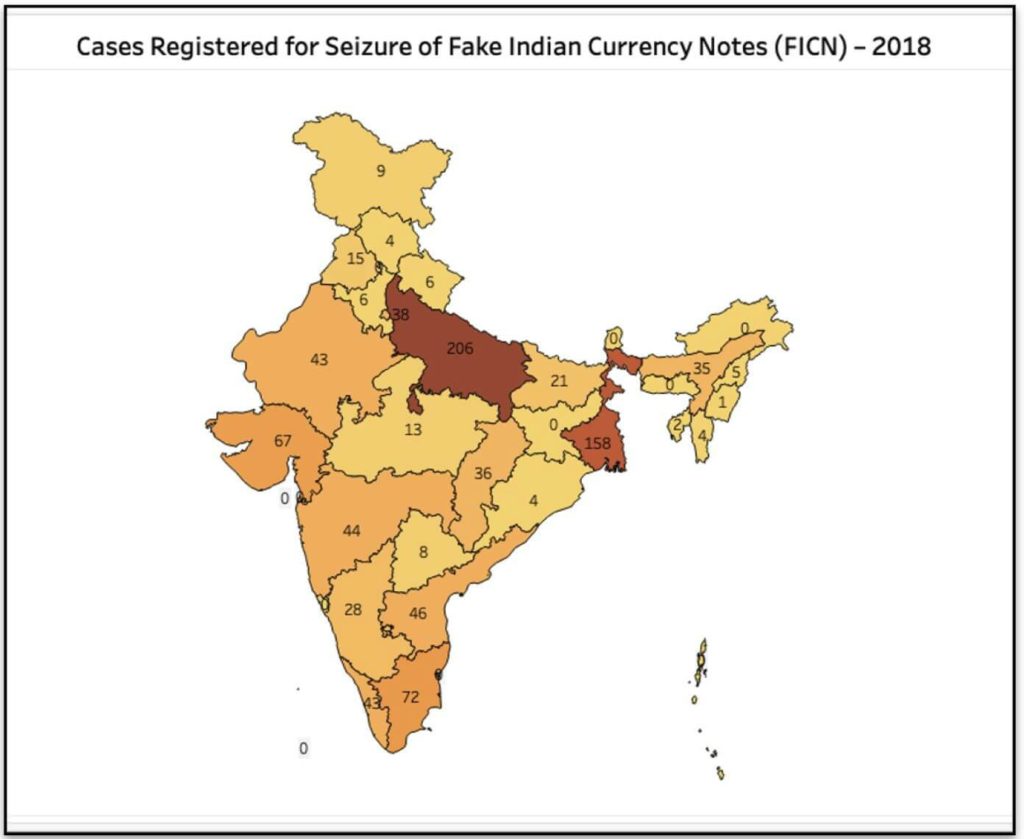
Number of Incidents reduce compared to 2014
Prior to 2016, the number of FIRs filed and the number of accused in counterfeiting cases were not provided in the NCRB data. However, the reports for 2014 and 2015 included the incidence of the such crimes. In 2014, the number of incidents of counterfeiting currency/bank notes was 1667 which fell over the subsequent years until 2017. The incidence of cases was 1662, 1443 and 1144 for 2015,2016 and 2017 respectively. However, the incidence of counterfeiting of currency/bank notes increased marginally in 2018 to 1233.
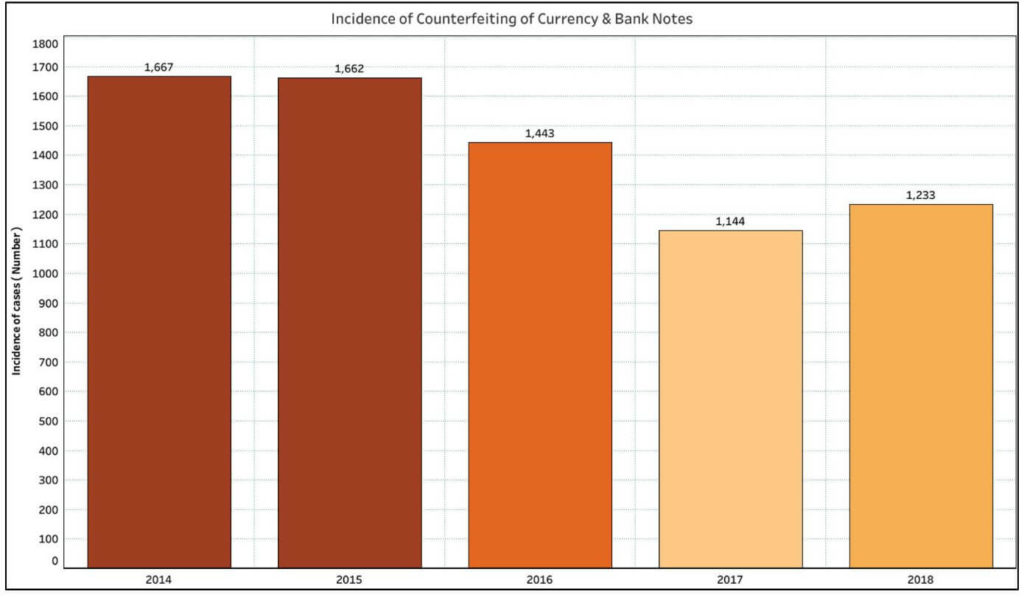
In 2018, highest volume by value of FICN seized in Delhi
While the highest number cases were filed in UP for 2018, Delhi which had reported only 38 FIRs, recorded the highest value of FICN seized with ₹ 3.63 crores. A total of more than ₹ 17.95 crores worth of fake Indian currency was seized in 2018 across the country.
In Tamil Nadu, fake notes worth of more than ₹ 2.84 crores were seized, followed by West Bengal where ₹ 2.11 crores were seized. Other states where more than one crore worth of fake notes seized include : Karnataka (₹ 1.71 crores), Uttar Pradesh (₹ 1.33 crores), Gujarat (₹ 1.23 crores), Maharashtra (₹ 1.15 crores) and Andhra Pradesh (₹ 1.13 crores). Mizoram, which is one of the smaller states in India and has only 4 cases filed in 2018. But the fake currency worth ₹ 73.7 lakhs were seized here in 2018.
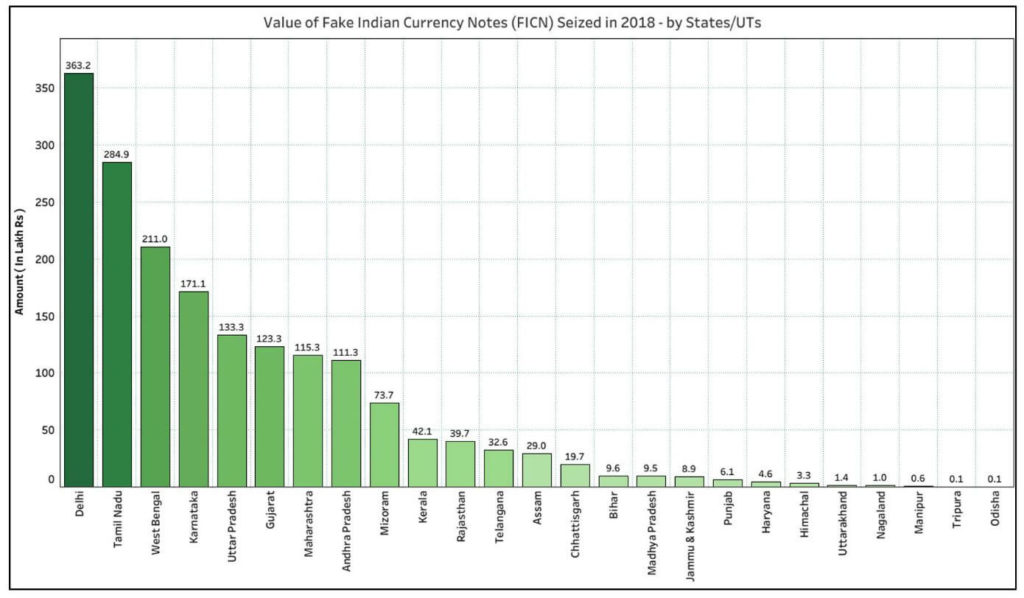
Major share of amount seized in Delhi consists of demonetized ₹ 500 and ₹ 1000 notes.
A significant portion of the amount seized in Delhi during 2018 are the demonetized ₹1 000 and ₹ 500 notes. A total of 13,138 fake notes of ₹ 1000 and a further 13,596 fake notes of older ₹ 500 were seized in Delhi. Delhi also recorded the highest number of fake ₹100 notes with more than 31 thousand such notes. In Gujarat, more than 14000 fake ₹100 notes were seized.
Among the new notes that were released post demonetization, most fake notes of ₹ 2000 denomination were seized in Tamil Nadu (more than 12000). West Bengal, Delhi and Karnataka are among the other states where a significant number of ₹2000 notes were seized in 2018.
A major portion of fake currency seized in Mizoram are the new high value notes with 3494 of ₹ 2000 denomination and 764 notes of ₹ 500 denomination.
Relatively fewer fake notes of the new ₹500 denomination, released post-demonetization, were seized in 2018. The highest number of such fake 500 Rupee notes were seized in Gujarat followed by Maharashtra, Andhra Pradesh and Karnataka.
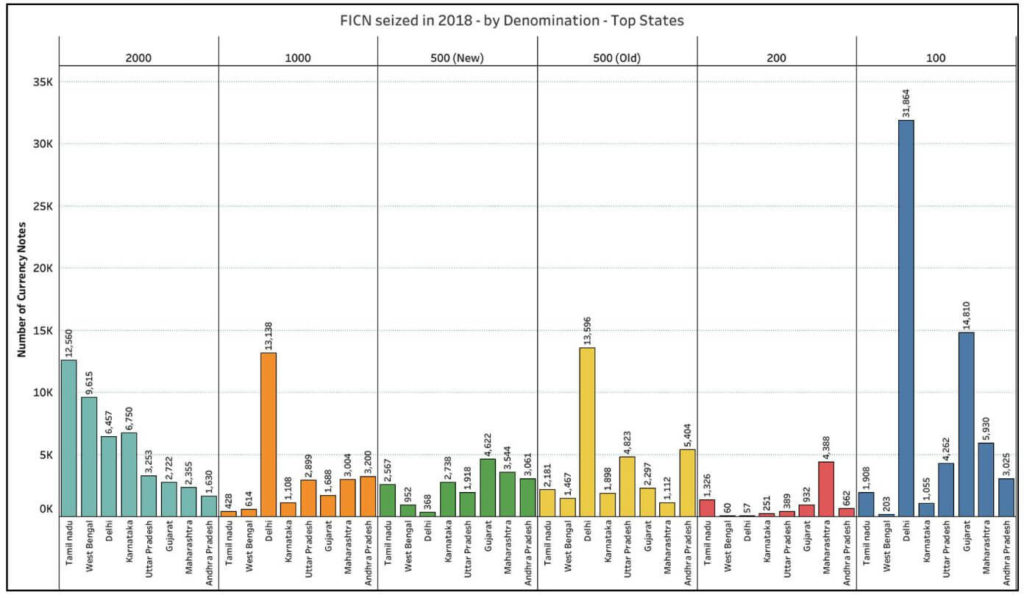
80,000 + counterfeit high value notes of ₹ 2000 & ₹ 500 seized in 2017 & 2018
RBI released the new ₹ 500 and ₹ 2000 currency notes as the high value denominations after demonetization.
In the year 2017, nearly 75 thousand counterfeit notes of ₹ 2000 denomination were seized. This number reduced in 2018 to nearly 55 thousand such fake notes. The number of counterfeit notes seized of the new ₹500 denomination was 8879 in 2017 which increased by nearly three times in 2018 when 26 thousand such fake notes were seized.
The new notes were released during November 2016 post demonetization, and it is important to note that within the remaining two months of 2016 i.e. November and December 2272 counterfeit notes of ₹ 2000 were seized.
Among the other new notes issues by RBI, 155 counterfeit notes of ₹ 50 were seized in 2017 which increased to 5215 in 2018.

Value of Fake Currency seized higher in 2017 & 2018
In the two years post demonetization, the total value of FICN seized was ₹ 17.95 crores in 2018 and ₹28.1 crores in 2017.
Although the total value of fake notes seized in 2018 is less than that of 2017, the value in both these years is greater than the value of fake notes seized in 2016 and before. The data as per NCRB report does not specify the details of the value seized post demonetization in 2016 and in the 10 months prior to it. However, the total fake currency seized in 2016 was worth ₹ 15.92 crores. The value in 2016 was significantly higher than the value of 2014 and 2015 which was ₹3.03 crores and ₹ 90.6 lakhs respectively.
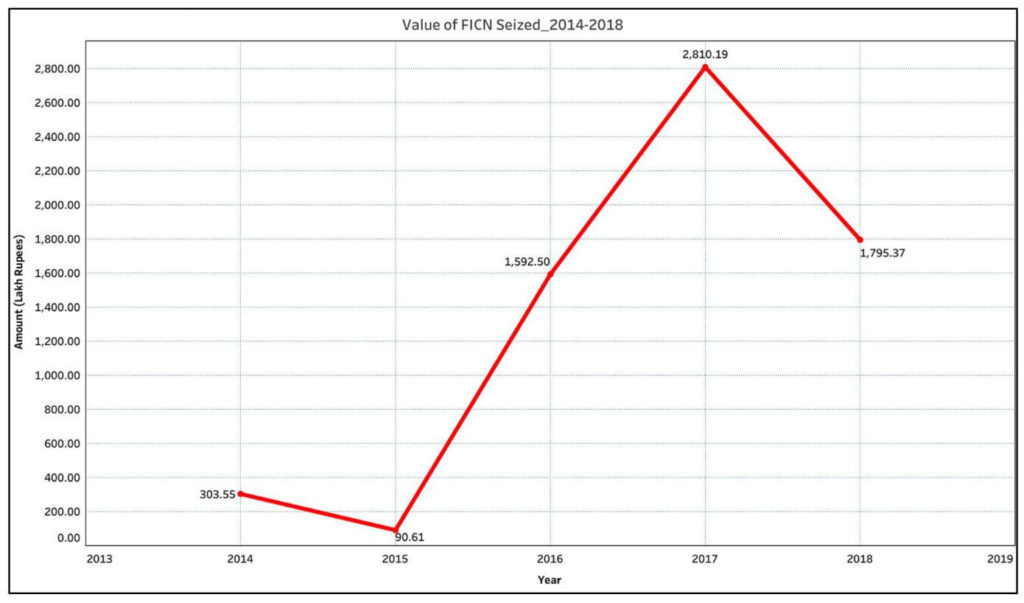
Higher number of FCIN seized of the new currency notes does not meet one of the purposes of demonetization.
While the value of FICN seized during 2017 and 2018 is higher than earlier, it is also significant to note that a major share of this value includes the new notes of ₹2000 and ₹500. This is similar to the trend observed from the numbers reported in RBI’s annual report. Factly had earlier noted that the number of fake notes detected in the banking system of the new currency increased in 2018.
The government has maintained that the new notes were introduced with high security features to prevent counterfeiting. However, the increasing volume of counterfeit notes of the new currency is a cause for concern. It has to be noted that the numbers indicated in the NCRB reports are only those which have been seized by law enforcement agencies and where a case has been filed. The estimate of the total volume of such notes in circulation is not known.


